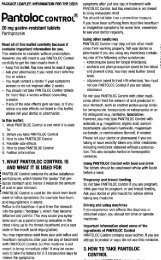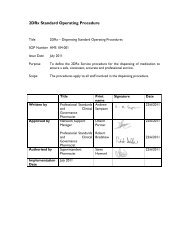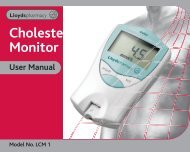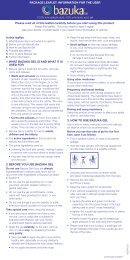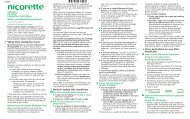PATCH PROGRAMME - LloydsPharmacy
PATCH PROGRAMME - LloydsPharmacy
PATCH PROGRAMME - LloydsPharmacy
You also want an ePaper? Increase the reach of your titles
YUMPU automatically turns print PDFs into web optimized ePapers that Google loves.
4<br />
rhythm) or stroke for which you are in hospital. Using nicotine replacement<br />
therapy is better than continuing to smoke<br />
• have serious liver or kidney disease<br />
• have ever had a stomach ulcer<br />
• are diabetic (see next section)<br />
• have an overactive thyroid gland<br />
• have a tumour of the adrenal gland (phaeochromocytoma)<br />
• are taking any other medicines (see next section)<br />
• are pregnant or breast-feeding (see Pregnancy/Breast-feeding sections).<br />
Taking other medicines<br />
Please tell your doctor or pharmacist if you are taking or have recently taken any<br />
other medicines, including medicines obtained without a prescription.<br />
The effect of some medicines can be altered when you stop smoking.<br />
• If you are already taking regular medication you should tell your doctor, nurse<br />
or pharmacist.<br />
• Diabetics should monitor their blood sugar levels more often than usual when<br />
starting to use a patch because insulin/medication requirements may alter.<br />
Pregnancy<br />
Smoking during pregnancy is associated with risks such as poor growth of the baby<br />
before birth, premature birth or still birth. Stopping smoking is the single most<br />
effective way to improve both your health and that of your baby. The earlier smoking<br />
stops, the better.<br />
Ideally, stopping smoking during pregnancy should be done without nicotine<br />
replacement therapy. However, if you have tried and this is not possible, nicotine<br />
replacement therapy may be used because the risk to the developing baby is less<br />
than that expected from continued smoking.<br />
The decision to use nicotine replacement therapy should be made as early on in the<br />
pregnancy as possible with the aim of discontinuing use after 2-3 months. Patches<br />
may be preferred if you have nausea or sickness. If patches are used, they should be<br />
removed before going to bed at night.<br />
Ask your doctor for advice before taking any medicine.<br />
Breast-feeding<br />
It is better to use nicotine replacement therapy products that can be taken<br />
intermittently (not patches). Try to breast-feed at a time just before you take the<br />
product to ensure that the baby gets the smallest amount of nicotine possible.<br />
If you need to use nicotine replacement therapy to help you give up smoking, the<br />
amount of nicotine that the baby may receive is considerably smaller and less harmful<br />
than the secondhand smoke they would otherwise be breathing in.<br />
Driving and using machines<br />
These patches are unlikely to affect your ability to drive or operate machinery.<br />
3. HOW TO USE NICOTINELL <strong>PATCH</strong>ES<br />
Always use the patches exactly as your doctor, nurse or pharmacist has told you and always<br />
read the leaflet. Ask your doctor, nurse or pharmacist if you are not sure.<br />
The Nicotinell patch programme involves up to 3 steps. There are three patch sizes consisting of<br />
three different strengths: 7, 14 and 21 mg/24 hours.<br />
The correct dose for you depends on the number of cigarettes you smoke per day. The size of<br />
your patch may need to change during your treatment: This is because your dependence on<br />
nicotine will change, and therefore the dose of nicotine in your patch may be too low or too high<br />
for you. Do NOT cut the patches to reduce the dose.<br />
• If you smoke 20 or more cigarettes a day, start with:<br />
Step 1. Nicotinell TTS 30 (21mg/24 hours) patches for 3-4 weeks, followed by,<br />
5




